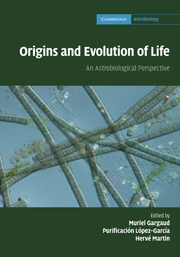Book contents
- Frontmatter
- Contents
- List of contributors
- Foreword
- Preface
- Part I What is life?
- 1 Problems raised by a definition of life
- 2 Some remarks about uses of cosmological anthropic ‘principles’
- 3 Minimal cell: the biologist's point of view
- 4 Minimal cell: the computer scientist's point of view
- 5 Origins of life: computing and simulation approaches
- Part II Astronomical and geophysical context of the emergence of life
- Part III The role of water in the emergence of life
- Part IV From non-living systems to life
- Part V Mechanisms for life evolution
- Part VI Life in extreme conditions
- Part VII Traces of life and biosignatures
- Part VIII Life elsewhere?
- Index
4 - Minimal cell: the computer scientist's point of view
from Part I - What is life?
Published online by Cambridge University Press: 04 February 2011
- Frontmatter
- Contents
- List of contributors
- Foreword
- Preface
- Part I What is life?
- 1 Problems raised by a definition of life
- 2 Some remarks about uses of cosmological anthropic ‘principles’
- 3 Minimal cell: the biologist's point of view
- 4 Minimal cell: the computer scientist's point of view
- 5 Origins of life: computing and simulation approaches
- Part II Astronomical and geophysical context of the emergence of life
- Part III The role of water in the emergence of life
- Part IV From non-living systems to life
- Part V Mechanisms for life evolution
- Part VI Life in extreme conditions
- Part VII Traces of life and biosignatures
- Part VIII Life elsewhere?
- Index
Summary
Introduction to artificial life
Would a theoretical biologist be surprised to be told that computer use and software developments should help him make substantial progress in his discipline? It is doubtful. There is a long tradition of software simulations in theoretical biology to complement pure analytical mathematics which are often limited to reproducing and understanding the self-organization phenomena resulting from non-linear and spatially grounded interactions of the huge number of diverse biological objects. Nevertheless, proponents of artificial life would bet that they could help them further by enabling them to transcend their daily modelling/measuring practice by using software simulations in the first instance and, to a lesser degree, robotics, in order to abstract and elucidate the fundamental mechanisms common to living organisms. They hope to do so by resolutely neglecting much materialistic and quantitative information deemed as not indispensable. They want to focus on the rule-based mechanisms making life possible, supposedly neutral with respect to their underlying material embodiment, and to replicate them in a non-biochemical substrate. In artificial life, the importance of the substrate is purposefully understated for the benefit of the function (software should ‘supervene’ to an infinite variety of possible hardware). Minimal life begins at the intersection of a series of processes that need to be isolated, differentiated and duplicated as such in computers. Only software development and usage make it possible to understand the way these processes are intimately interconnected in order for life to appear at those crossroads.
- Type
- Chapter
- Information
- Origins and Evolution of LifeAn Astrobiological Perspective, pp. 47 - 65Publisher: Cambridge University PressPrint publication year: 2011

